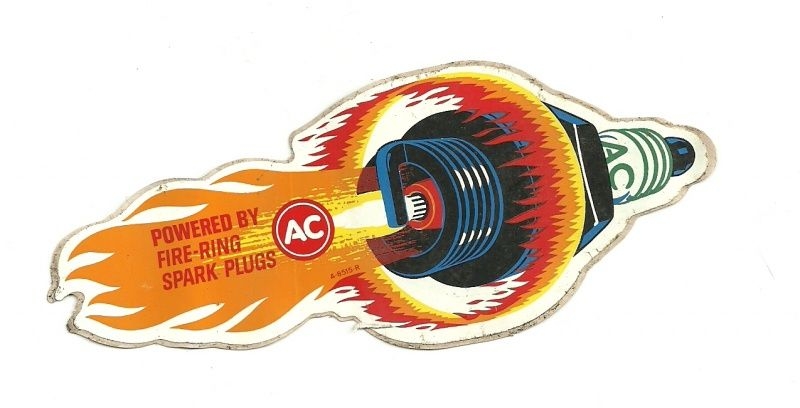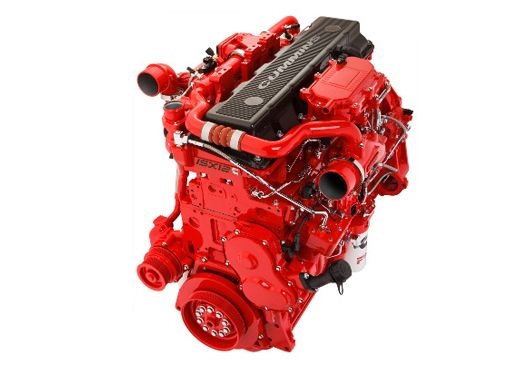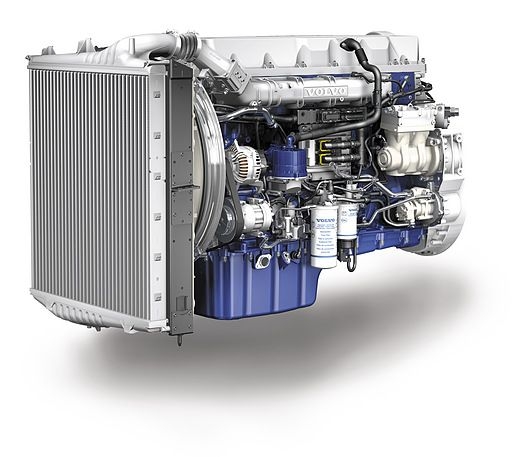Powering Natural Gas Trucks: The Spark
 The difference between a diesel engine and a gasoline engine is a combination of the fuel and the way the engine ignites the fuel to create power. Diesels are compression engines; the heat of the compressed air in the cylinder ignites the lower ignition point of the distilled oil. Gasoline engines are spark-ignited engines, in which the heat of an electric spark ignites the gasoline.
The difference between a diesel engine and a gasoline engine is a combination of the fuel and the way the engine ignites the fuel to create power. Diesels are compression engines; the heat of the compressed air in the cylinder ignites the lower ignition point of the distilled oil. Gasoline engines are spark-ignited engines, in which the heat of an electric spark ignites the gasoline.
Diesel engines are less complex than gasoline engines. There are not as many parts, like coils, spark plugs, plug wires, points, and distributors. However, diesels require fuel injectors to spray the fuel into the cylinder as the piston compresses the air in the cylinder, generating the heat needed to ignite the oil. Gasoline engines can use carburetors to introduce the fuel to the air stream before charging the cylinder, but diesels require the precise timing of the fuel injector to work properly. Previously, we ran an article about the birth of the diesel engine, which also talks about the magic of the thermal engine.
 The diesel engine became the transportation power workhorse for good reasons. Of all of the fuels derived from petroleum, fuel oil (diesel) is easiest to make. Fuel 0il, which includes diesel, kerosene, and the different Jet fuels (like JET-A) are all forms of distilled oil. In the process, the different compounds vaporize out of the heated crude oil, and then are condensed into the distilled liquids. Some gasoline comes out of this process, called straight run gasoline. The fuel oils all come out of this first run process, and then go through different steps to convert them into kerosene, Jet-A and diesel. The only difference between the fuel oil used to heat homes and the diesel in trucks is a color dye put into heating oils to keep trucking companies from using it to avoid fuel taxes.
The diesel engine became the transportation power workhorse for good reasons. Of all of the fuels derived from petroleum, fuel oil (diesel) is easiest to make. Fuel 0il, which includes diesel, kerosene, and the different Jet fuels (like JET-A) are all forms of distilled oil. In the process, the different compounds vaporize out of the heated crude oil, and then are condensed into the distilled liquids. Some gasoline comes out of this process, called straight run gasoline. The fuel oils all come out of this first run process, and then go through different steps to convert them into kerosene, Jet-A and diesel. The only difference between the fuel oil used to heat homes and the diesel in trucks is a color dye put into heating oils to keep trucking companies from using it to avoid fuel taxes.
Until WWII, most trucks ran on gasoline, while fuel oils flowed to heat homes and businesses. Power demands changed after WWII, as did fuel demands. The pent up demand for automobiles drove up the demand for gasoline to fuel all of the cars that the expanded manufacturing systems could make. Trucks grew in size, needing more power. The technology of the time limited the compression power of a gasoline engine, which led General Motors and others to develop and refine two-stroke diesel power, creating engines with more torque that burned a plentiful and cheaper-than-gasoline alternative, diesel oil.
The pressure to change from diesel to an alternate fuel exists not because there is a better fuel available. Other factors, both economic and cultural, are creating an opportunity for alternatives to become attractive. I’m not going to address the cultural factors in this article. But in understanding natural gas as an alternative motor fuel, we should understand some of the economic factors that are beyond the economics of the fuel itself — things like engine design and maintenance.
Getting a Spark
Natural gas engines work more like gasoline engines than diesels. Natural gas needs an ignition source, just like gasoline does. If it is ignited by compression, natural gas is less predictable, like gasoline, and is prone to detonation, not ignition. Detonation destroys the internal working parts of an internal combustion engine, so the timing of the heat source, the spark, is important.
Spark plugs add an additional level of complexity to the design and operation of the engine. Beyond the spark plug itself, the system now must support a coil to step the voltage up from 12 volts to 20,000 volts, a distributor to direct the power to the right plug, the wires to carry the high voltage charge to the plugs, and a mechanism to control the exact timing of the spark. Add the ignition system, and the NG engine becomes more like a gasoline engine.
 The Cummings-Westport natural gas engines, the medium-duty 8.9-liter ISL-G and the heavy-duty 12-liter ISX12-G, use spark plugs for ignition. The spark plugs used in the NG engines are not the same class as the plugs in a lawnmower, but perhaps approach the sensitivity and longevity of the plugs in automobiles and light trucks with service levels of 100,000 – 150,000 miles before maintenance. Costs are a factor, however. While a modern automobile spark plug can cost as much as $15, the cost of the plugs used in 9-liter and 12-liter natural gas engines approaches $100 per plug.
The Cummings-Westport natural gas engines, the medium-duty 8.9-liter ISL-G and the heavy-duty 12-liter ISX12-G, use spark plugs for ignition. The spark plugs used in the NG engines are not the same class as the plugs in a lawnmower, but perhaps approach the sensitivity and longevity of the plugs in automobiles and light trucks with service levels of 100,000 – 150,000 miles before maintenance. Costs are a factor, however. While a modern automobile spark plug can cost as much as $15, the cost of the plugs used in 9-liter and 12-liter natural gas engines approaches $100 per plug.
The plugs themselves are sensitive to handling. Technicians must be careful about oil, grease, and moisture when handling the plugs. Add to that the complexity of the plug wires and the rest of the ignition systems, and the cost of maintenance goes up. This complexity is not substantial; automobile maintenance facilities deal with ignition systems every day, so there is a body of knowledge, tools, and training infrastructure to support it. Traditional diesel engine mechanics and technicians require training, which also costs money.
Liquid Spark
Several engine builders are working on dual fuel technology that does not need a spark plug. In these cases, a little bit of diesel injected into the combustion chamber at the moment of highest compression becomes a liquid sparkplug that ignites the natural gas and drives the power stroke.
Westport Technologies developed a 15-liter natural gas engine based on this High-Pressure Direct-Injection (HPDI) technology. Westport aimed the 15-liter engine for the heavy duty, over-the-road market. With soft market demand for the big engine, Westport pulled the engine from the market in late 2013. The Westport HDPI engine, since it burned diesel, required Diesel Exhaust Fluid (DEF) and used the SCR emissions process to meet US EPA regulations. Even with diesel accounting for about 5 percent of the total fuel mixture, the Westport 15-liter engine still carried the costs and burdens of the current diesel emissions regulations.
 Volvo trucks introduced the first integrated (engine and truck made by the same company) NG engine with the D13-LNG compression-ignition engine. The 13-liter compression-ignition engine uses a small amount of diesel fuel to ignite the LNG. Volvo claims that the engine delivers diesel-like durability and performance in terms of horsepower and torque, and about 20 percent greater fuel efficiency than spark-ignition natural gas engines.
Volvo trucks introduced the first integrated (engine and truck made by the same company) NG engine with the D13-LNG compression-ignition engine. The 13-liter compression-ignition engine uses a small amount of diesel fuel to ignite the LNG. Volvo claims that the engine delivers diesel-like durability and performance in terms of horsepower and torque, and about 20 percent greater fuel efficiency than spark-ignition natural gas engines.
Caterpillar, which exited the US over-the-road diesel market when the last set of EPA regulations came online, continues to build diesels for the off-road, marine, and field power markets. About half of the current oil and gas drilling rigs use CAT power to create the electricity and mechanical power used on the well site. In off-road use, Caterpillar is working on designs to create NG-powered mine- and earth-moving equipment for contained and dedicated fleets.
Fuel System Complexity
The fuel delivery systems that move natural gas from the tank to the engine are far more complex than diesel and gasoline technology. While natural gas engines take fuel in the same way (as a gas injected into the cylinder), Compressed Natural Gas (CNG) and Liquefied Natural Gas (LNG) use different forms of technology to store, control, and convert the gas from storage to power feeding the engine.
Both fuel systems come with their own sets of features and inherent flaws. CNG is under tremendous pressure, up to 2,600 psig in full tanks. With CNG systems, regulators and piping must withstand and contain these very high pressures. Carbon fiber-wound tanks require hoses and connections, specialized inspections, testing instruments, and tools.
LNG is cryogenic; that is, it remains a liquid only at very low temperatures, at least 240 degrees below zero. LNG systems are more complex than CNG systems, with special pumps, valves, vaporizers, vents, and other devices. The liquid is constantly attempting to return to a gaseous state, and the system vents the gas to reduce the pressure if the truck's engine is not able to consume the gas. LNG fuel systems require specialized inspections, testing instruments, and tools.
Natural gas is almost all methane, a lighter-than-air gas that dissipates quickly in open spaces. However, methane can ignite at the point of release. Roofs, mezzanines and other structures can trap methane under them, where it just waits for an ignition source, as this story about cows in Germany illustrates. A repair facility supporting a natural-gas-powered fleet needs to take protective safety measures to exhaust gas that may leak from the maintenance process. Some of the requirements, like exhausts, are not difficult to install, and make sense even for diesel operations. Other requirements, like gas detection systems and other fire-prevention or safety-related items will be determined at a local level, following the interpretation of NFPA suggested regulations by the local Fire Marshals.
For either fuel type, the tools and equipment necessary to maintain the fleets require a capital investment. Gas detection systems and exhaust systems require capital investment. Maintenance personnel need additional training, beyond their diesel maintenance training, which is an ongoing operations expense. There is much more to the cost of the operation of a natural gas fleet than the trucks and the fuel.
Total Additional Maintenance Costs
There are a host of other smaller maintenance costs that may increase the per-mile expense of an NG-fueled fleet. Then again, these costs may be a wash.
Most of the NG fleets in operation prior to 2013 were small local operations in which the trucks returned to base every day, such as trash collection trucks. Big announcements of new NG fleet purchases started to appear in 2013, and to date there is not much long-term data to rely on. Ryder Systems, Inc. is the only fleet operator with extensive long haul experience — reportedly 15 million miles. Ryder reports an additional 1.5 cents per mile in operating cost for the NG fleet over diesel services. Smaller fleets with fewer miles report a range of one to two cents more per mile.
None of the data released details of what goes into the cost assessment, so we don’t know if that cost included the initial investment of tools and facility, or the training of personnel in the shops. Some maintenance experts report that since natural gas engines do not enjoy the same natural lubricity as diesel trucks, NG trucks require more frequent oil changes with more specialized oils (lower ash content oils).
Any worthwhile cost analysis must identify all of these factors, treating one-time costs as one-time costs, not as recurring expenditures. As fleet experience grows, we expect that the per-mile maintenance costs for natural gas trucks will eventually be on equal footing with diesels.
Ryder is leading the way in providing LNG and CNG fleet operations to the market. In support of the demand in Southern California (and the need for port truck maintenance), Ryder has opened the first NG truck maintenance facility in Rancho Dominguez, just up the 710 Freeway from the Port of Long Beach — along the path of the majority of the port's traffic.
Articles in This Series
This video highlights the maintenance differences between the Cummings - Westport ISL-G and the diesel sibling, ISL-9 diesel.


